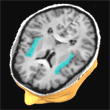Monday, 12 May 2014
We May Be Able To Have Feelings Without an Insula

The insula is a brain structure that lies deep inside the cerebral cortex and so is less accessible for examination. That is why so little was known about the insula for so long, until neurobiologists such as Antonio Damasio demonstrated its role in many human feelings. Because the insula receives so many signals from the strong internal bodily reactions associated with even our slightest emotions, it was seen as perfectly positioned to make us aware of these reactions.
That is what Damasio says in a February 2013 article in the journal Nature Reviews Neuroscience, in which he goes on to say that the role of the insula in generating our feelings may be more limited than some might believe. He points out several observations that are not highly consistent with the strong thesis that the insula is the essential platform for human emotions, and, by extension, for human consciousness, which develops from them.
First of all, Damasio points out that the many neural nuclei in the upper brainstem receive information from the body before the insula does. These nuclei can produce their own fairly elaborate representations of many of the body’s states, and so the contribution of these nuclei to our feelings should not be minimized a priori.
Next, Damasio points to various individuals in whom the insula is absent (for example, in babies born without a cerebral cortex) or has been destroyed (for example, as the result of especially damaging forms of encephalitis). Most such individuals still retain a rich palette of emotions.
Damasio therefore concludes that the generation of feelings must necessarily also depend on the brainstem and possibly also on the SI and SII somatosensory cortices of the parietal lobe, which are generally intact in individuals whose insula has been destroyed but who still have a rich emotional life.
Considering other individuals who have suffered cortical damage that has not affected their emotional responses, Damasio even goes so far as to say that the hypothalamus probably plays a central role in the generation of human feelings, thus stressing the survival value evolutionarily associated with even the slightest emotions.
The neuronal substrate of our most sophisticated feelings, from compassion to happiness to sadness to, may thus be grounded in brain structures that were present well before the emergence of the cerebral cortex that now lets us turn these feelings into exalting or devastating poems.
![]() Is the insula necessary for our feelings? If not, where are they?
Is the insula necessary for our feelings? If not, where are they?
![]() The nature of feelings: evolutionary and neurobiological origins
The nature of feelings: evolutionary and neurobiological origins
Emotions and the Brain | Comments Closed







